Goooood morning fellow speakerdudes!
In this thread I'm going to talk about a modest, relatively tiny pair of CHR-70 speakers that play flat to 20hz!
I'm doing this using CHR-70s in sealed as near-field computer speakers. DSP is provided by a parametric EQ VST-plugin which I am using with the Foobar music player.
NOTE: I am NOT using the EQ to do anything other than roughly emulate a Linkwitz transform circuit, and thus "unwrap" the low frequency falloff imposed by the sealed box. I have taken no acoustic measurements of these speakers as of yet and am not even applying any baffle step correction. (note the attach pictures, in the location the speakers are at combined with the natural response of the CHR-70, I don't feel they need any)
Disclaimer: I like to type, and I like to ramble. If you don't feel like reading, here's the TL;DR. Holy crap! They sound amazing!
In this thread I'm going to talk about a modest, relatively tiny pair of CHR-70 speakers that play flat to 20hz!
I'm doing this using CHR-70s in sealed as near-field computer speakers. DSP is provided by a parametric EQ VST-plugin which I am using with the Foobar music player.
NOTE: I am NOT using the EQ to do anything other than roughly emulate a Linkwitz transform circuit, and thus "unwrap" the low frequency falloff imposed by the sealed box. I have taken no acoustic measurements of these speakers as of yet and am not even applying any baffle step correction. (note the attach pictures, in the location the speakers are at combined with the natural response of the CHR-70, I don't feel they need any)
Disclaimer: I like to type, and I like to ramble. If you don't feel like reading, here's the TL;DR. Holy crap! They sound amazing!
Chapter 1: Background and Preconceptions
I have built a couple pairs of CHR-70 based speakers in Bass Response enclosures and have always been quite impressed with these little guys. They're not perfect, but in the world of cheap consumer audio that we live in, these drivers being "not perfect" still puts them above a sound quality threshold that I feel most people in the world (even us in the the rich music-loving first world) have never heard.
The pair of speakers I'm going to be talking about are a prototype that I built simply to test some new construction techniques. The techniques have little to do with the sound quality and more to do with aesthetics. Namely, an entirely miter-jointed box with baffle-edge bevels and inlay. The construction techniques actually have little to do with this article except as background; in order to keep things simple and small, I built these speakers as sealed boxes instead of bass reflex. As I was going to be keeping these for myself as near-field computer speakers, I figured the bass would be "good enough," and then I could use some bass boost where appropriate.
I had also been reading about utilization of EQ to craft the bass response of a particular sealed driver, but namely I'd been looking into it as a method of building compact subwoofers for 2.1 sets. When I made the decision to build these as sealed boxes I also made the decision to play around with this a little more. Since these will be used on a computer, I figured I could use my computer as a DSP sandbox!
Since I'm listening to them near-field in a small room, I don't need too much output capability, which would allow me to get away with more low-frequency extension. The lower you go, the less maximum output you have, but if you're never listening louder than.. I dunno, 82db at 3ft from the speakers, you can get away with a LOT. Furthermore, the CHRs have a fairly serious about of linear travel for a speaker of their size; they'll move nearly a centimeter peak-to-peak!
I assumed it would be a neat experiment. I assumed it would probably sound good! What I did not assume was that these guys would rewrite how I think about sound reproduction and sound system design.
Clean, flat response down to the lower limits of human hearing by itself is certainly something to be heralded, but honestly the biggest thing these speakers have shown me is how much the group-delay/decay issues of a BR really hurt the sound.
I may never build another BR box again.
I have built a couple pairs of CHR-70 based speakers in Bass Response enclosures and have always been quite impressed with these little guys. They're not perfect, but in the world of cheap consumer audio that we live in, these drivers being "not perfect" still puts them above a sound quality threshold that I feel most people in the world (even us in the the rich music-loving first world) have never heard.
The pair of speakers I'm going to be talking about are a prototype that I built simply to test some new construction techniques. The techniques have little to do with the sound quality and more to do with aesthetics. Namely, an entirely miter-jointed box with baffle-edge bevels and inlay. The construction techniques actually have little to do with this article except as background; in order to keep things simple and small, I built these speakers as sealed boxes instead of bass reflex. As I was going to be keeping these for myself as near-field computer speakers, I figured the bass would be "good enough," and then I could use some bass boost where appropriate.
I had also been reading about utilization of EQ to craft the bass response of a particular sealed driver, but namely I'd been looking into it as a method of building compact subwoofers for 2.1 sets. When I made the decision to build these as sealed boxes I also made the decision to play around with this a little more. Since these will be used on a computer, I figured I could use my computer as a DSP sandbox!
Since I'm listening to them near-field in a small room, I don't need too much output capability, which would allow me to get away with more low-frequency extension. The lower you go, the less maximum output you have, but if you're never listening louder than.. I dunno, 82db at 3ft from the speakers, you can get away with a LOT. Furthermore, the CHRs have a fairly serious about of linear travel for a speaker of their size; they'll move nearly a centimeter peak-to-peak!
I assumed it would be a neat experiment. I assumed it would probably sound good! What I did not assume was that these guys would rewrite how I think about sound reproduction and sound system design.
Clean, flat response down to the lower limits of human hearing by itself is certainly something to be heralded, but honestly the biggest thing these speakers have shown me is how much the group-delay/decay issues of a BR really hurt the sound.
I may never build another BR box again.
Chapter 2: The drivers
About a year and a half ago I got my first drivers for the purposes of building my own loudspeakers. Based on reading I'd done, mostly on this site, I figured going with a full-range design would be best, to reduce complexity.
People seemed to be excited about the MarkAudio CHR-70, and with good reason. It looked good, sounded good, is truly a FULL range speaker, capable of deep bass as well as high treble, and all of this for an affordable price! I was set.
I ordered a gold pair and promptly designed and BR enclosure for them using winISD. After I made some initial prototypes with these, I tweaked the design slightly and made a set for a friend as computer speakers. I pulled the original drivers out of the prototypes and put them back in their boxes. Since then they've acted as my shop-mules. I pull them out in the shop when I need to measure or test-fit a CHR-70 and I don't want to get a new one all dusty!
One of these I dropped onto my bench, which has given it a small buzz in a specific frequency range somewhere in the mid. Normally not noticeable unless something hits just the right note!
I needed something cheap for my new prototype, as I have little-to-no cash at the moment, so I pulled these guys out again. After almost 2 years of being abused in a shop, they've finally reached their final resting place and are doing what they do best: impressing people!
About a year and a half ago I got my first drivers for the purposes of building my own loudspeakers. Based on reading I'd done, mostly on this site, I figured going with a full-range design would be best, to reduce complexity.
People seemed to be excited about the MarkAudio CHR-70, and with good reason. It looked good, sounded good, is truly a FULL range speaker, capable of deep bass as well as high treble, and all of this for an affordable price! I was set.
I ordered a gold pair and promptly designed and BR enclosure for them using winISD. After I made some initial prototypes with these, I tweaked the design slightly and made a set for a friend as computer speakers. I pulled the original drivers out of the prototypes and put them back in their boxes. Since then they've acted as my shop-mules. I pull them out in the shop when I need to measure or test-fit a CHR-70 and I don't want to get a new one all dusty!
One of these I dropped onto my bench, which has given it a small buzz in a specific frequency range somewhere in the mid. Normally not noticeable unless something hits just the right note!
I needed something cheap for my new prototype, as I have little-to-no cash at the moment, so I pulled these guys out again. After almost 2 years of being abused in a shop, they've finally reached their final resting place and are doing what they do best: impressing people!
Attachments
Chapter 3: The speakers
My previous speakers had all been black. Black vinyl with a textured black baffle, and silver speakers. This just happened to be what people wanted, and was fairly easy to do with the techniques that I was using.
For my next set, a set of Alpair-10 based monitors for a friend, I wanted to start moving up in the world and play with real-wood finishes. I wanted to utilize pre-veneered board at first, to reduce cost and construction time, but this comes with its own challenges. Basically, everything on the box has to be a miter joint.
It took a good amount of experimentation, especially since I don't have an ultra-fancy woodshop at my disposal, but I managed to work things out and get a pretty good result!
The in-lay is a 1/4" thick strip of solid walnut, which "wraps" around the top of the box. I have not applied any stain or finish to the wood, as of yet.
The box is 1/2" "birch ply" (they call it birch ply, it's really just veneered MDF). 1/2" is generally thinner than I'd like, but the birch actually stiffens it up quite a bit over regular 1/2" MDF. the box is braced internally at several points to help make up for the thin material. The baffle is double-thick, largely to give more bite for the speaker mounting screws, but also to help deal with driver vibration.
There are no electronic components in the speakers, save the drivers themselves. Just wires that connect to terminals at the back.
There is also currently no stuffing in these, either. I had meant to experiment with some, but I want to do that objectively by way of acoustic measurement. As-is, I haven't noticed any big peaks or resonances due to this.
The speakers should be VERY air-tight, as I liberally applied adhesive caulk to all the interior seems.
An irrelevant aside. I accidentally wired the left one out of phase internally! Oops. Will have to fix that someday
My previous speakers had all been black. Black vinyl with a textured black baffle, and silver speakers. This just happened to be what people wanted, and was fairly easy to do with the techniques that I was using.
For my next set, a set of Alpair-10 based monitors for a friend, I wanted to start moving up in the world and play with real-wood finishes. I wanted to utilize pre-veneered board at first, to reduce cost and construction time, but this comes with its own challenges. Basically, everything on the box has to be a miter joint.
It took a good amount of experimentation, especially since I don't have an ultra-fancy woodshop at my disposal, but I managed to work things out and get a pretty good result!
The in-lay is a 1/4" thick strip of solid walnut, which "wraps" around the top of the box. I have not applied any stain or finish to the wood, as of yet.
The box is 1/2" "birch ply" (they call it birch ply, it's really just veneered MDF). 1/2" is generally thinner than I'd like, but the birch actually stiffens it up quite a bit over regular 1/2" MDF. the box is braced internally at several points to help make up for the thin material. The baffle is double-thick, largely to give more bite for the speaker mounting screws, but also to help deal with driver vibration.
There are no electronic components in the speakers, save the drivers themselves. Just wires that connect to terminals at the back.
There is also currently no stuffing in these, either. I had meant to experiment with some, but I want to do that objectively by way of acoustic measurement. As-is, I haven't noticed any big peaks or resonances due to this.
The speakers should be VERY air-tight, as I liberally applied adhesive caulk to all the interior seems.
An irrelevant aside. I accidentally wired the left one out of phase internally! Oops. Will have to fix that someday
Attachments
Chapter 4: The Setup
This is where it gets kinda amusing.
First, I needed an amp. I don't really have any spares laying around save car-audio amplifiers, which are just a hassle to deal with, what with needing a 12volt power supply and all that. Fortunately, a friend of mine was clearing out his condo and dug up an old Yamaha R-8 receiver which he donated to the cause.
Then comes the EQ. I have human.bin (a member on this forum) to thank for pointing me toward the correct software. I am running the Foobar2000 music player. I'm using a VST wrapper plug-in to allow me to use VST effects plugins. Finally, for EQing I'm using the AiXcoustic Creations Elictri-Q parametric Equalizer.
For a sound card I'm using an E-MU Tracker Pre. I'm interfacing with the card using ASIO.
Now, the thing about digital EQ like this is that in order to make something louder, all I'm doing is increasing number values that represent certain aspects of a sound wave. Those number values are all capped within a specific range. If you increase those numbers past that cap, they stop increasing, and you get major distortion. So, if the sound wave is already loud and nearly maxed out, which most recordings are these days, there is little to no headroom for gain.
The solution is that you actually have to attenuate everything that you DON'T want louder. In the screenshot of my EQ configuration, I actually had to bring up the level a bit just so you could see the whole EQ curve, as the plug-in apparently wasn't designed for this much gain/attenuation. I normally run the setup so the highest point at 20hz is at 0db, and everything else drops off the bottom of the window.
The problem, then, is that your music is now very quiet, and all the other sounds on your computer are VERY LOUD in comparison. This makes the whole setup rather annoying and unusable! My solution is a convoluted one, where once again I'm scrapping together parts that I happen to have laying around.
The sound player outputs to the E-MU external sound card directly, but my default windows sound device I've left to my laptop's internal sound card. I then run both sound cards into a little Eurorack mixer, so I can adjust the gain of each sound card separately! The mixer then outputs to the amp.
I have the speakers set on stacks of books mostly so the drivers are more on-axis with my ear. Old programming books still have uses!
Also: oatmeal is a delicious and nutritious breakfast!
This is where it gets kinda amusing.
First, I needed an amp. I don't really have any spares laying around save car-audio amplifiers, which are just a hassle to deal with, what with needing a 12volt power supply and all that. Fortunately, a friend of mine was clearing out his condo and dug up an old Yamaha R-8 receiver which he donated to the cause.
Then comes the EQ. I have human.bin (a member on this forum) to thank for pointing me toward the correct software. I am running the Foobar2000 music player. I'm using a VST wrapper plug-in to allow me to use VST effects plugins. Finally, for EQing I'm using the AiXcoustic Creations Elictri-Q parametric Equalizer.
For a sound card I'm using an E-MU Tracker Pre. I'm interfacing with the card using ASIO.
Now, the thing about digital EQ like this is that in order to make something louder, all I'm doing is increasing number values that represent certain aspects of a sound wave. Those number values are all capped within a specific range. If you increase those numbers past that cap, they stop increasing, and you get major distortion. So, if the sound wave is already loud and nearly maxed out, which most recordings are these days, there is little to no headroom for gain.
The solution is that you actually have to attenuate everything that you DON'T want louder. In the screenshot of my EQ configuration, I actually had to bring up the level a bit just so you could see the whole EQ curve, as the plug-in apparently wasn't designed for this much gain/attenuation. I normally run the setup so the highest point at 20hz is at 0db, and everything else drops off the bottom of the window.
The problem, then, is that your music is now very quiet, and all the other sounds on your computer are VERY LOUD in comparison. This makes the whole setup rather annoying and unusable! My solution is a convoluted one, where once again I'm scrapping together parts that I happen to have laying around.
The sound player outputs to the E-MU external sound card directly, but my default windows sound device I've left to my laptop's internal sound card. I then run both sound cards into a little Eurorack mixer, so I can adjust the gain of each sound card separately! The mixer then outputs to the amp.
I have the speakers set on stacks of books mostly so the drivers are more on-axis with my ear. Old programming books still have uses!
Also: oatmeal is a delicious and nutritious breakfast!
Attachments
Thanx for the article. Note: i fixed the thread title, CHR-70 is a nominal 4" driver.
dave
Okay! I was just referring to the cone size, but I suppose there are standards for this type of thing, and they're best to stick to to reduce confusion. Thanks!
I hope everyone can excuse my ramblings
Very interesting  The only thing bugging me is that no matter which way you look at it, i doubt you'd ever be able to hear a 20Hz tone from the drivers. I may be wrong, but you need at least 75Db @ 20Hz to even hear anything.
The only thing bugging me is that no matter which way you look at it, i doubt you'd ever be able to hear a 20Hz tone from the drivers. I may be wrong, but you need at least 75Db @ 20Hz to even hear anything.
If you come accross tracks with deep bass i should imagine you need to back off the volume somewhat? Effectively in that situation i doubt you'd be able to play them very loud at all just in case..
Other than that it was an interesting exercise, you had fun & now you have a nice looking pair of decent sounding full range speakers, congratulations
If you come accross tracks with deep bass i should imagine you need to back off the volume somewhat? Effectively in that situation i doubt you'd be able to play them very loud at all just in case..
Other than that it was an interesting exercise, you had fun & now you have a nice looking pair of decent sounding full range speakers, congratulations
Very interestingThe only thing bugging me is that no matter which way you look at it, i doubt you'd ever be able to hear a 20Hz tone from the drivers. I may be wrong, but you need at least 75Db @ 20Hz to even hear anything.
If you come accross tracks with deep bass i should imagine you need to back off the volume somewhat? Effectively in that situation i doubt you'd be able to play them very loud at all just in case..
Other than that it was an interesting exercise, you had fun & now you have a nice looking pair of decent sounding full range speakers, congratulations
You're probably correct, but I'd really like to do some objective tests. I've played around with the signal generator in WinISD, but I've found it to be extremely... noisy? not optimal, anyway. I always get lots of artifacts and distortion that I don't get in other things.
Some .wav files of good clean test tones would be optimal, I think. Have any handy?
EDIT: From a technical standpoind, winISD calculates the maximum SPL from two CHR-70s running in these sealed boxes to be a combined 73db at 20hz, so... pretty close, but probably just below that threshold. However, 75db happens at about 23hz, and by 30hz it's up to 80db
Last edited:
No, i'm sorry i don't. I'd normally use a function generator for things like that. Seeing as you mention it though i do happen to have an old test record that does frequencies down to at least 20Hz, perhaps it's time to make use of my old Traxdata CD recorder & burn myself a test CD with the generatorSome .wav files of good clean test tones would be optimal, I think. Have any handy?
Never thought of that
E2A:- Here is an equal loudness curve for you. You should definately be able to hear 30Hz, even if at low volume
E2A yet again:- As we have possibly established that trying to get to 20Hz is or might be a waste of time & boost, why not settle on 30Hz as a compromise? At least that way you can play your music a little louder..
Last edited:
very nice to see things are working out! i have to experiment this by myself oneday, i've a pair of alpair6 to go with, hopefully they'll do the job...
also i think there is a lot of range to get a good full-sounding system, one does not need necessarily the 20hz flat, still can play it flat to 35-40hz with gentle roll-off and see how loud it can get.
biggest problem it seems to have it system wide or even accept external sources... software solutions i can not find under windows or mac... so i tought of the miniDSP board, or maybe something like the DDX amplifier thing, those things infact have a true digital input which is passed trough DSP and then directly drives the t-class amp section, all-in one dac dsp (not as fancy as the miniDSP but still should allow for this kind of thing) and t-amp! the 50w evaluation board is also quite affordable altough i don't know yet what it takes to program them...
ps. if you need more db range in the equalizer click "M"enu -> skin -> range... you can set up to +/- 30db
also i think there is a lot of range to get a good full-sounding system, one does not need necessarily the 20hz flat, still can play it flat to 35-40hz with gentle roll-off and see how loud it can get.
biggest problem it seems to have it system wide or even accept external sources... software solutions i can not find under windows or mac... so i tought of the miniDSP board, or maybe something like the DDX amplifier thing, those things infact have a true digital input which is passed trough DSP and then directly drives the t-class amp section, all-in one dac dsp (not as fancy as the miniDSP but still should allow for this kind of thing) and t-amp! the 50w evaluation board is also quite affordable altough i don't know yet what it takes to program them...
ps. if you need more db range in the equalizer click "M"enu -> skin -> range... you can set up to +/- 30db
E2A yet again:- As we have possibly established that trying to get to 20Hz is or might be a waste of time & boost, why not settle on 30Hz as a compromise? At least that way you can play your music a little louder..
Actually, if you look at the screenshot of my EQ curve, you'll noticed that the gain tapers off a little bit below 30hz, so yeah, that's basically what I was doing.
However, the next build I plan on doing will be a similar thing, except with a pair of Alpair10 drivers. The Alpair10s not only have almost double the surface area, but they have nearly double the linear excursion capability. Thus, by winISD's calculations, maximum SPL of both speakers combined comes in at 80db!
The fun part is that, due to the A10s much lower Qts, it accomplishes this in a box with barely over HALF the internal volume of the CHR-70!
ps. if you need more db range in the equalizer click "M"enu -> skin -> range... you can set up to +/- 30db
Huh! Look at that. And here I thought I searched everywhere...
Just took a look & i agree, nicely done! Looking forward to the bigger smaller Alpair 10sActually, if you look at the screenshot of my EQ curve, you'll noticed that the gain tapers off a little bit below 30hz, so yeah, that's basically what I was doing.
However, the next build I plan on doing will be a similar thing, except with a pair of Alpair10 drivers. The Alpair10s not only have almost double the surface area, but they have nearly double the linear excursion capability. Thus, by winISD's calculations, maximum SPL of both speakers combined comes in at 80db!
The fun part is that, due to the A10s much lower Qts, it accomplishes this in a box with barely over HALF the internal volume of the CHR-70!
Jeez, that happens to me to.. I swear i used to be able to change the size of the whole Winamp console on my laptop, but i just don't have a clue now & like yourself i have been through everything a good few timesHuh! Look at that. And here I thought I searched everywhere...

When listening to music on the lappy i plug it into an old JVC "Super A" amp & Mission 780s, quite acceptable i must say...
Bests to you, Mark.
Will be trying this soon myself. I thought I needed to get an equaliser working for my squeezebox, but it seems I can listen to internet radio via foobar, so it answers all my desktop listening needs 
I am about to buy a squeezebox boom as an interim solution to my lack of music, and to try it out. If you read this white paper: http://wiki.slimdevices.com/uploads/a/ad/Logitech_Squeezebox_Boom_Audio_Design.pdf you will see it includes a lot of good stuff. It will EQ the bass up as high as possible depending on volume setting.
I suppose I could do something similar (with foobar) if I want to crank it up I could choose a less aggressive bass boost curve.
Just fired up my test box, CHR-70 in 9l BR. But it seems the effort may have been unnecessary, should have tried the sealed EQ route first.
I am about to buy a squeezebox boom as an interim solution to my lack of music, and to try it out. If you read this white paper: http://wiki.slimdevices.com/uploads/a/ad/Logitech_Squeezebox_Boom_Audio_Design.pdf you will see it includes a lot of good stuff. It will EQ the bass up as high as possible depending on volume setting.
I suppose I could do something similar (with foobar) if I want to crank it up I could choose a less aggressive bass boost curve.
Just fired up my test box, CHR-70 in 9l BR. But it seems the effort may have been unnecessary, should have tried the sealed EQ route first.
Just fired up my test box, CHR-70 in 9l BR. But it seems the effort may have been unnecessary, should have tried the sealed EQ route first.
Having some experience with the 70 is similar boxes I can say that it does quite well and still manages to impress. A BR box is still far more flexible, as it doesn't require any special processing to sound "right," and as such you can run it off any 'ol amp. The two sets I built previously are both running off the little Dayton T-amps, to great success.
When I do the Alpair10 set, I will also be constructing an LM3886-based amplifier with an actual Linkwitz transform circuit built in, so it will be a more flexible all-in-one solution.
As it is, it sounds great, but it's also a pain in the ***
Here's something fun to try. Keep the volume low, then play (off youtube if you don't have it) 15 step by radiohead.
Keep the volume low until the bass starts, then see how they go. The fundamental is around 30Hz, so they should cope.
I'm interested in this because my sub (pair of 8" drivers) uses a linkwitz circuit, too. The max SPL is very limited on tracks like the one mentioned above. I understand how you feel when you say it's a pain.
Chris
Keep the volume low until the bass starts, then see how they go. The fundamental is around 30Hz, so they should cope.
I'm interested in this because my sub (pair of 8" drivers) uses a linkwitz circuit, too. The max SPL is very limited on tracks like the one mentioned above. I understand how you feel when you say it's a pain.
Chris
Looking at winISD it seems we can get 73dB at 30Hz. I suspect that might be plenty for listening at 2feet distance. For all I know it's enough to fill the room for most listening (flat battery on RS sound meter, and I have no feel for this).
Using EQ on a sealed box CHR70, what difference does box size make? eg say 9l vs 3l box ?
Using EQ on a sealed box CHR70, what difference does box size make? eg say 9l vs 3l box ?
- Status
- This old topic is closed. If you want to reopen this topic, contact a moderator using the "Report Post" button.
- Home
- Loudspeakers
- Full Range
- My CHR-70+DSP Linkwitz Transform experiment (4" driver playing flat to 20hz!)







